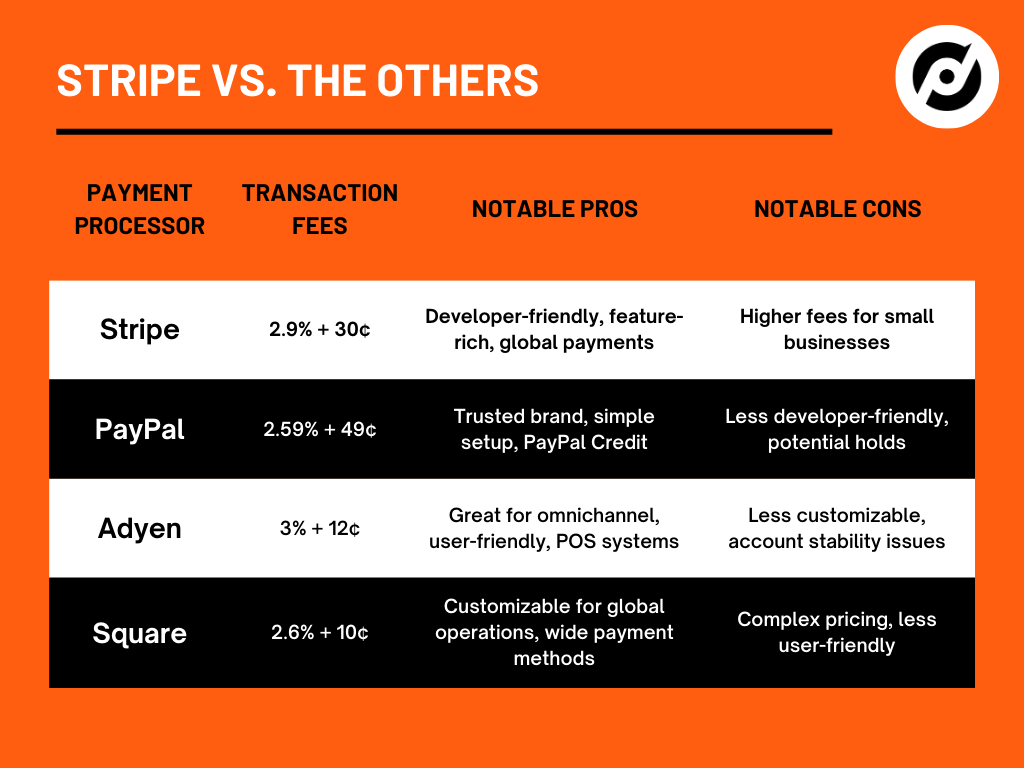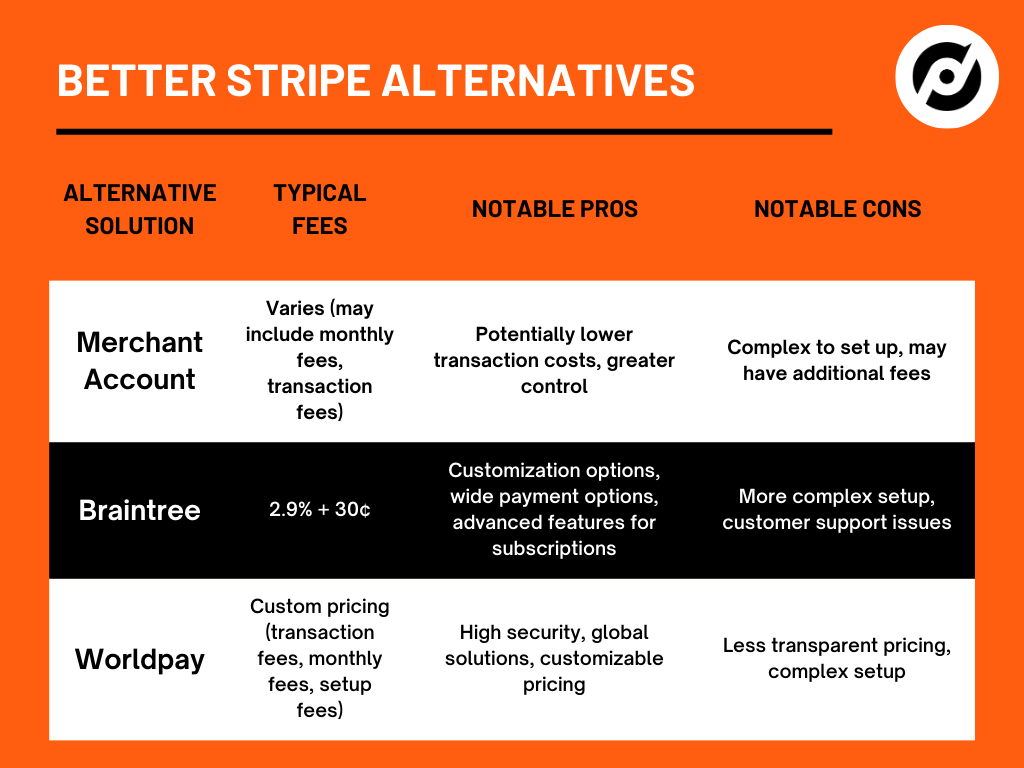
Stripe Is Too Expensive! | Stripe Fees Breakdown + Alternatives
Jul 10, 2023 4 minutes
Imagine this: You’ve just started your online store and decided to use Stripe for payment processing. Fast forward a few months, and you’re excitedly checking your earnings only to find that (1) a significant chunk of your profits has vanished into thin air, OR (2) your shop is frozen!
Stripe is no doubt one of the giants in the payment processing world. With its slick interface, a plethora of features, and the ease with which it can be integrated into almost any website, it’s no wonder that countless online merchants and e-commerce platforms opt to use Stripe payment processing as their go-to solution.
However, there’s a caveat. Stripe’s pricing model might not be as transparent or as affordable as one might think at first glance. For the uninitiated, deciphering Stripe’s fee structure can be akin to navigating a labyrinth, with unexpected costs lurking around every corner.
In this article, we’ll shine a light on the maze that is Stripe’s fee structure, and arm you with the information you need to make an informed decision for your business. We’ll break down each fee, analyze whether Stripe is really as expensive as some claim, and provide you with viable alternatives that could save you money without compromising on quality.
Stripe Fees Breakdown
Stripe has a reputation for its simplicity and ease of use, but when it comes to pricing, things can get a bit more complicated. Let’s unravel Stripe’s flat-rate pricing model and its various fees.
Flat-Rate Pricing Model
At its core, Stripe operates on a flat-rate pricing model. This means that for every online transaction, you’re charged a fixed percentage plus a fixed fee. The standard rate for online transactions is 2.9% + 30 cents per successful charge for businesses in the United States.
However, it’s worth noting that payment processing fees can vary by country, so it’s important to check Stripe’s pricing page for the most current rates applicable to your location.
Additional Service Fees
Besides the basic transaction fees, Stripe offers additional services that come with their own set of costs:
- Stripe Radar: This is Stripe’s fraud prevention tool. While basic Radar features are included in the transaction fees, Radar for Fraud Teams, which offers more advanced capabilities, costs an additional fee per transaction.
- Stripe Billing: If you’re using Stripe for subscription services, Stripe Billing can handle recurring billing. The cost for this service depends on your usage, with a percentage fee charged on recurring charges.
- Stripe Connect: This is ideal for platforms that need to payout to third parties. It’s an intricate service with a variable pricing structure that depends on the features you’re using.
Hidden Costs
There are several Stripe processing fees that you might not be aware of when you start using Stripe:
- Currency Conversion Fees: If you’re accepting international payments in a currency different from your account’s default currency, Stripe charges an additional conversion fee.
- Chargeback Fees: In case of a disputed charge, such as when a customer doesn’t recognize a transaction, there is a fee for the chargeback process. If the dispute is resolved in your favor, the fee may be refunded.
- Refund Processing Fees: If you refund a transaction, Stripe doesn’t return the original transaction fee. This means you lose the processing fees of the original charge.
Real-Life Impact
To paint a clearer picture, let’s consider a practical example. Imagine you are a US-based merchant with an average transaction value of $50. If you process 100 transactions in a month, your base transaction fees alone will be around $320 [(2.9% of $50 + $0.30) x 100]. If you have a couple of chargebacks, need currency conversions, or use additional services, this figure can escalate quickly.
It’s essential to be aware of these costs and factor them into your pricing strategy. Knowing how much each transaction actually costs you can help in making informed decisions regarding the payment processors you choose.
Looking for a way out of Stripe without harming your business? We can help!
Is Stripe Really Too Expensive?
Now that we’ve broken down the various fees associated with using Stripe, it’s time to address the elephant in the room: Is Stripe really too expensive for your business? The answer to this question is not a simple yes or no, as it depends on several factors including the scale of your business, your specific needs, and what you value in a payment processor.
Value and Services vs. Cost
One of the reasons why Stripe is a popular choice among online merchants is the suite of tools and features it offers. From seamless integration, a robust API, to fraud prevention with Stripe Radar, there’s a lot that comes packaged with Stripe’s service. For some businesses, these features may justify the costs, as they can contribute to smoother operations and potentially higher conversions.
However, for small businesses or those with tight margins, the costs can add up quickly and become a significant burden. In such cases, the value provided by Stripe may not justify its fees.
Nor does the abysmal Stripe support process. The company can hold your funds for 180 business days and makes it nearly impossible to get in touch with them.
Pricing Model Difference
Stripe utilizes a flat-rate pricing model, just like PayPal and Square. But this isn’t the only pricing model. It is, however, the simplest.
In fact, Stripe isn’t a payment processor at all. It’s what we call a payment aggregator.
Some credit card payment processors charge a separate fee for each payment type, which can be a good thing depending on what your customers use most frequently. For example, you may pay more on Stripe for ACH direct debit and international cards, or even something as common as American Express, than on another processor.
Look at the pricing model for the service provider you’re interested in closely and make sure that the fees you pay are acceptable or negotiable.
Customization and Negotiation
Stripe may be open to customization, but the cost is much higher than going with a negotiable alternative, like having your own merchant account. If you processor tens of thousands per month, then Stripe likely isn’t the best solution for you. In fact, it might be harmful to keep using it as your primary payment processor as Stripe likes to freeze accounts and hold funds for businesses who process too much.
Your Business Needs
In the end, whether or not Stripe is too expensive boils down to your specific business needs. If the features, integrations, and security provided by a Stripe account are critical for your business operations and customer experience, the costs may be justifiable. However, if you’re operating on slim margins and don’t require the full suite of services that Stripe offers, you might find better value in an alternative solution.
Stripe Competitors
As a business owner, it’s always smart to weigh your options. Though Stripe is a formidable player in the payment processing arena, it’s not the only game in town. Let’s take a closer look at some of Stripe’s major competitors, and see how they stack up.
It’s worth noting that all of the alternatives (as well as Stripe) accept every major credit card (Visa, Mastercard, Amex), Apple Pay, and Google Pay.
PayPal
One of the most recognized names in the online payments industry, PayPal is often the go-to alternative to Stripe.
- Fees Breakdown: PayPal’s standard transaction fees are similar to Stripe’s at 2.59% + $0.49 per transaction for sales within the US.
- Pros:
- Highly recognized and trusted by consumers.
- Simple setup, doesn’t require a merchant account.
- Offers PayPal Credit to customers.
- Cons:
- PayPal’s interface and customization options are not as developer-friendly as Stripe’s.
- May hold funds under certain circumstances, which can affect cash flow.
Square
Square is best known for its point-of-sale (POS) systems, but it also offers a robust online payment processing solution.
- Fees Breakdown: Square’s fees for online transactions are similar to both Stripe and PayPal at 2.6% + $0.10 per transaction.
- Pros:
- Excellent for businesses with both online and physical storefronts.
- Feature-rich POS systems.
- User-friendly interface.
- Cons:
- Not as customizable or developer-friendly as Stripe.
- Some users report issues with account stability.
Adyen
Adyen is a global payment company that allows businesses to accept payments in multiple currencies, both online and in physical stores.
- Fees Breakdown: Adyen has a different fee structure compared to Stripe. It charges a processing fee plus a payment method fee, which varies depending on the payment method used, but we can generalize at 3% + $0.12 per transaction.
- Pros:
- Highly customizable and feature-rich for global operations.
- Supports a wide variety of payment methods.
- Capable of handling large payments.
- Cons:
- More complex pricing structure which can be confusing.
- Not as user-friendly for those without technical expertise.

Stripe versus PayPal, Square, and Adyen.
Need help choosing an alternative? Reach out to our team!
Viable Alternatives to Stripe
While the competitors we discussed earlier are similar to Stripe in many ways, there are also alternative solutions that operate on different models. For some businesses, particularly those with higher payment volumes or specific needs, these alternatives might be more cost-effective or better suited.
Merchant Accounts
One of the traditional alternatives to payment processors like Stripe is to set up a merchant account.
- What is it?: A merchant account is a type of bank account that allows businesses to accept payments via credit or debit cards. Merchant accounts often involve relationships with banks and credit card networks.
- Fees Breakdown: Merchant accounts generally have a more complex fee structure, which can include monthly fees, transaction fees, and other costs. However, they may offer lower transaction fees, especially for businesses with higher sales volumes.
- Pros:
- Lower transaction costs for high-volume businesses.
- Greater control over transactions (including international transactions).
- More stability and fewer account holds.
- Cons:
- More complicated to set up and manage.
- May have additional monthly or annual fees.
- Typically requires more administrative work.
Braintree
Though technically part of PayPal, Braintree operates as a distinct service catering primarily to businesses looking for a more customizable payment solution.
- Fees Breakdown: Braintree’s fees are similar to Stripe’s at 2.9% + $0.30 per transaction for US transactions.
- Pros:
- Provides more customization options compared to PayPal.
- Supports a wide variety of payment options.
- Advanced features for subscription services.
- Cons:
- Slightly more complex to set up compared to Stripe or PayPal.
- Customer support is not always as responsive.
Worldpay
Worldpay is a global payment processing provider catering to businesses of all sizes, with a special emphasis on security and fraud protection.
- Fees Breakdown: Worldpay offers custom pricing, so fees vary. They may include transaction fees, monthly fees, and setup fees.
- Pros:
- Highly secure and focused on fraud prevention.
- Offers global payment solutions.
- Customizable pricing can be advantageous for some businesses.
- Cons:
- Pricing is less transparent.
- Can be more complicated to set up and manage.

Comparing merchant accounts against the two largest real, accessible payment processors.
When considering an alternative to Stripe, it’s crucial to assess not just the cost but also the features, security, and the compatibility with your unique business model. While merchant accounts might offer cost benefits and customization options, they do come with added complexities.
Solutions like Braintree and Worldpay might be more suited for businesses with specific needs around customization, security, and global operations. As always, make sure to verify current fees and features before making your decision.
Ready to move away from Stripe and onto a more profitable partnership?
Deciding on the right payment processor is pivotal for your online business. While Stripe offers an array of features and simplicity, it’s essential to weigh the costs against the benefits, and consider if there might be a more fitting solution for your specific needs and scale.
For businesses operating in high-risk industries, traditional payment processors like Stripe, PayPal, or Square might not be the most favorable options due to their policies and fee structures. In such cases, a high-risk merchant account can provide the flexibility and support that high-risk businesses require.
DirectPayNet specializes in high-risk merchant accounts, offering customized solutions that are tailored to the unique challenges and requirements of high-risk industries. If your business operates in a space that’s considered high-risk, or if you’re experiencing issues with account holds, excessive fees, or a lack of specialized support, opening a high-risk merchant account with DirectPayNet could be the game-changing move for your business.
Here’s why DirectPayNet stands out:
- Expertise in High-Risk Industries: DirectPayNet has years of experience serving high-risk industries, understanding the intricacies and challenges involved.
- Customized Solutions: With DirectPayNet, your payment processing solution is tailored to your business, ensuring that it aligns with your specific needs.
- Dedicated Support: High-risk businesses often require specialized support, and DirectPayNet offers dedicated account managers to assist you through every step.
Your checkout is one of the most important—yet overlooked—aspects of your sales funnel. Don’t leave it to chance, secure the credit card processing power you need right now.
Take the next step and contact DirectPayNet to discuss how a high-risk merchant account can elevate your business to new heights.




